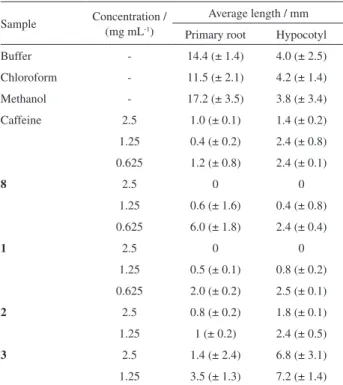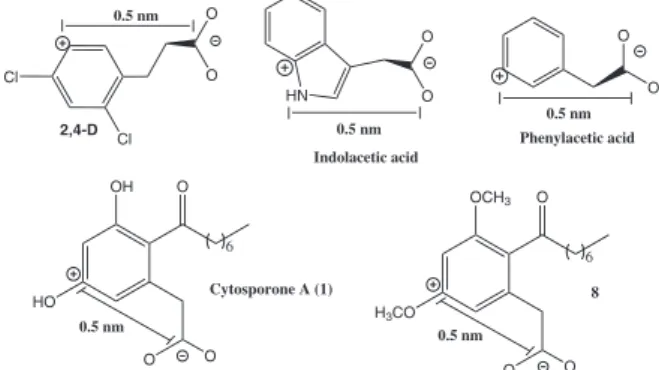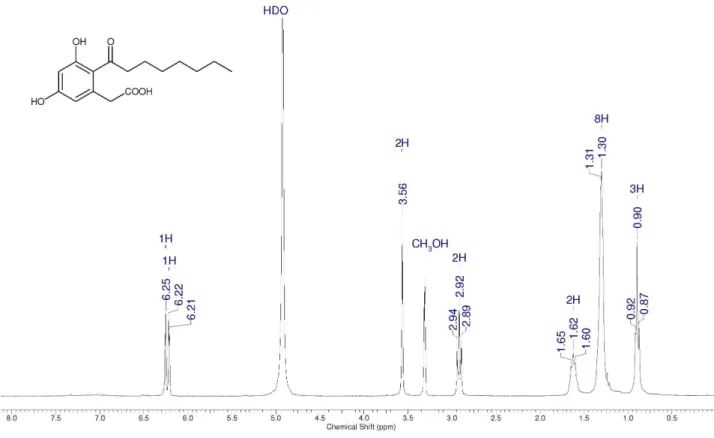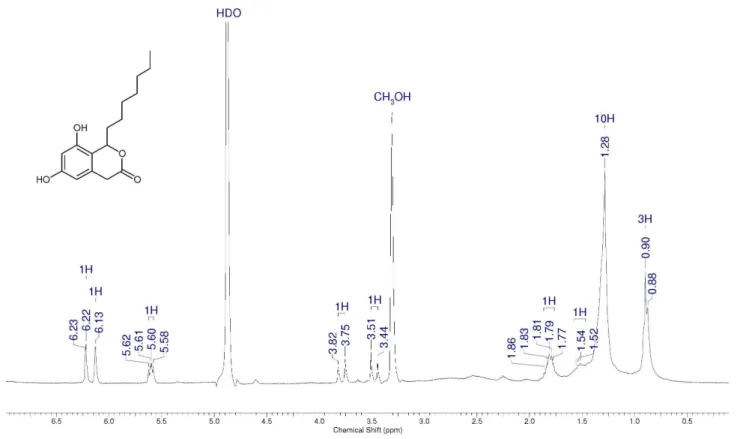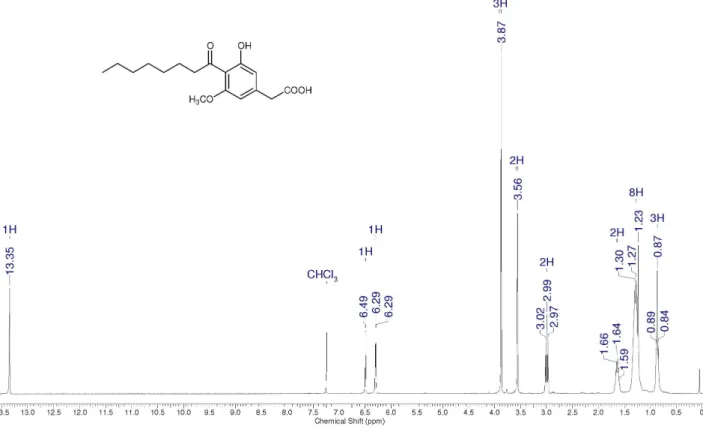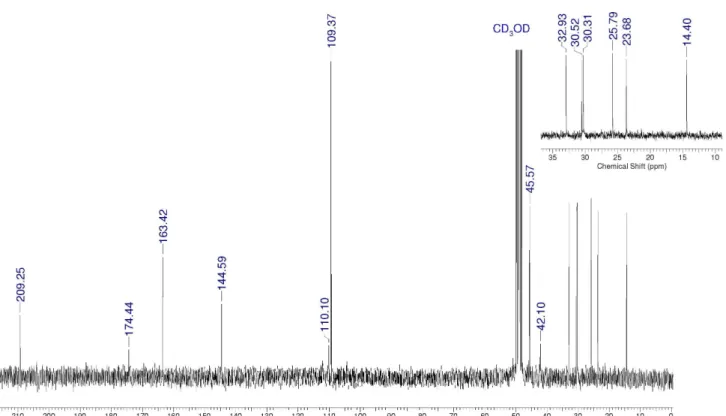Article
J. Braz. Chem. Soc., Vol. 23, No. 1, 124-131, 2012. Printed in Brazil - ©2012 Sociedade Brasileira de Química 0103 - 5053 $6.00+0.00
A
*e-mail: adilson.beatriz@ufms.br
Total Synthesis and Allelopathic Activity of Cytosporones A-C
Charles E. M. Zamberlam,a Alisson Meza,a Carla Braga Leite,b Maria Rita Marques,b
Dênis P. de Limaa and Adilson Beatriz*,a
aCentro de Ciências Exatas e Tecnologia, Universidade Federal de Mato Grosso do Sul,
Av. Senador Filinto Müller, 1555, 79074-460 Campo Grande-MS, Brazil
bCentro de Ciências Biológicas e da Saúde, Universidade Federal de Mato Grosso do Sul,
Cidade Universitária s/n, 79070-900 Campo Grande-MS, Brazil
A busca por herbicidas eficientes e ambientalmente corretos tem sido foco de numerosos estudos sobre a síntese de compostos isolados de fontes naturais. Citosporonas, as quais são lipídeos fenólicos isolados de fungos, apresentam notáveis propriedades biológicas. Este artigo relata a preparação das citosporonas A, B e C, através de uma rota sintética curta e com excelentes rendimentos. Os compostos sintetizados foram avaliados quanto às suas atividades alelopáticas em sementes de alface (Lactuca sativa L). Citosporona A e seu precursor metilado mostraram notável atividade alelopática, inibindo a germinação de sementes e crescimento das plântulas.
The search for efficient, environmentally friendly herbicides has been the focus of numerous studies on the organic synthesis of compounds isolated from natural sources. Cytosporones, which are phenolic lipids isolated from fungi, exhibit noteworthy biological properties. This paper reports the preparation of cytosporones A-C from the same starting material through a short synthetic route, with good yields. All compounds were tested for allelopathic activity on lettuce (Lactuca sativa L) seeds. Cytosporone A and its methylated precursor showed remarkable allelopathic activity, inhibiting seed germination and plantule growth.
Keywords: cytosporones, phenolic compounds, allelopathy, herbicides, Friedel-Crafts reaction
Introduction
Phenolic compounds with long hydrophobic side chains have been isolated as secondary metabolites from plants,
fungi, and bacteria since the beginning of the 20th century.
Within the plant kingdom, these natural amphiphilic compounds, termed phenolic lipids, can be found in the Gramineae, Leguminosae, and Anacardiaceae. Resorcinolic lipids and their derivatives have drawn the interest of researchers, given their range of biological properties, which allows these compounds to be used as antibiotic, antifungal, molluscicidal, antitumoral, antiparasitic, and antioxidant agents.1,2
In 2000, Brady et al.3 isolated five non-isoprenoid
octaketide phenolic lipids from the endophytic fungi
Cytospora sp. and Diaporthe sp., which were named
cytosporones A-E (1-5, Figure 1). Cytosporones D
and E (4 and 5) exhibited bactericidal activity against
Staphylococcus aureus, Enterococcus faecalis, and
Escherichia coli and fungicidal activity against Candida albicans. Cytosporone B (2) was later found to behave as a natural agonist ligand of the orphan nuclear receptor Nur77 of eukaryotic cells, which controls apoptosis in tumor cells and the metabolism of carbohydrates in mammals, properties that make it a potent and selective cytotoxic agent.4
Cytosporone A (1), also previously isolated from
a phytoparasitic fungus (Phoma sp.), regulates seed
germination factors at low concentrations, in addition to
having herbicidal potential.5
Inhibition of plant growth and development by compounds released in the environment by other plants or microorganisms is known as allelopathy. The term applies both to beneficial or detrimental interactions, involving either direct or indirect mechanisms. Allelochemicals can
be released in the substrate or volatilized.6 The role of
control. The active participation of researchers from various areas has raised allelopathy to a multidisciplinary field of investigation, leading it to evolve from a basic to an applied science, owing to its applications in agriculture and forestry.7
Weeds compete for resources with food cultures, decreasing the productivity of the latter and contaminating
subsequent cultivation through seed dispersal.8 Of an
estimated 7000 weed species, some 200 to 300 are considered pests, because of the considerable losses they inflict on producers, not only lowering productivity, but also increasing costs with herbicides. In 2004, the sector of agrochemicals in Brazil attained record sales, totaling US$ 4.495 billion. Herbicides alone are responsible for US$ 1.830 billion in sales, accounting for 54.1% of the
market for agricultural defensives.9 In the USA, expenses
with herbicides have reached around US$ 6 billion since the late 1990s, as a consequence of acquired resistance to herbicides in target plant species. In addition, the abuse of synthetic herbicides takes its toll on human, animal and
environmental health.8,10,11 These concerns are drawing
attention to alternative weed control technologies based
on natural products.8
From an agronomic viewpoint, the research on allelophathy provides perspectives for reduction of the use of traditional herbicides. In a so-called organic production, the herbicides are totally suppressed and replaced by allelophatic compounds or extracts whose action
mechanisms are generally very different.12 Furthermore,
the majority of allelophathic compounds are biodegradable
and less poluents than the traditional herbicides.13
Herbicides based on natural products have demonstrated advantages over their classic counterparts, with lower ecological impact. Synthetic derivatives or semisynthetic compounds of these natural products can be more active, more selective, and longer-lasting agrochemicals. By acting through a different mechanism than conventional herbicides, many allelochemichals are a good choice as
lead compounds to guide the discovery of new herbicides.8
Besides, the continuing search for new agrochemical products has demonstrated that natural selection has
been superior to combinatorial chemistry in developing
bioactive compounds with varied biological activities.14
These possibilities led our research group to focus on the development of new herbicides based on natural products obtained from microbial sources, and we have recently reported the synthesis of cytosporone analogues with
promising allelopathic activity.15 In the present article,
we report the total synthesis of cytosporones A (1), B (2),
and C (3) through a short, high-yield synthetic route. All
natural products and intermediates involved were tested for their potential inhibition of seed germination and plantule
development of lettuce (Lactuca sativa L., cv. Grand
Rapids - Asteraceae).
Results and Discussion
Synthesis
Employing retrosynthetic analysis (Scheme 1), cytosporones A-C can be prepared through a single connection, followed by FGIs. 3,5-Dimethoxybenzoic
acid (7) is commercially available at low cost. However,
an additional step is required to homologate the carbon
chain. For this purpose, phenylacetic acid 6 would be a
more reliable (albeit more costly) reagent, allowing the reconnection of 6 with 9 to yield the advanced intermediate
8. The subsequent steps would consist of simple FGIs
leading to formation of target compounds.
Scheme 2 shows the sequence of reactions selected
for direct synthesis of compounds 1, 2, and 3, involving
Friedel-Crafts acylation to form a C-C bond between the hydrophobic pendant and the hydrophilic aromatic ring.
3,5-Dimethoxyphenylacetic acid (6), used as the starting
material, underwent acylation with octanoyl chloride
in CH2Cl2 under reflux in the presence of AlCl3 as the
catalyst, giving the intermediate product
2-octanoyl-3,5-dimethoxyphenyl acetic acid (8), with 90% yield, and
compound 10, with 5% yield. The 1H NMR spectrum of 8
showed one triplet at dH 2.93 ppm (2H, J 7.0 Hz), which
typically indicates homotopic methylenic hydrogens adjacent to the carbonyl of a ketone; two doublets at
OH
HO
O OR
O HO OH
R
O
O
OH
HO HO
O
O
R = H, Cytosporone A (1) R = Et, Cytosporone B (2)
R = H, Cytosporone C (3) R = OH, Cytosporone D (4)
Cytosporone E (5)
dH 6.50 ppm (1H) and 6.43 ppm (1H), J 2.0 Hz, which
is consistent with aromatic hydrogens having a meta
relationship. 13C chemical shift and 1H-13C DEPT NMR
data confirmed the presence of 3 methyl, 7 methylene, 6 aromatic, 1 carboxyl carbon (at 172.3 ppm), and 1 carbonyl carbon atom (at 210.1 ppm). The transformation of the
compound 8 to the known cytosporone A (1), discussed
below, confirmed its structure.
The 1H NMR spectra of 10 had two aromatic hydrogen
signals, at dH 6.50 (d, 1H) ppm and 6.30 ppm (d, 1H),
J 2.0 Hz; a singlet at dH 13.35 ppm (1H), assigned to a
phenolic hydroxyl in a hydrogen bond, and a singlet at
dH 3.87 ppm (3H), in the region of aromatic methoxyls.
The 13C NMR spectra exhibited a signal at d
C 207.6 ppm
(C), related to a ketone carbonyl, and one single signal at
dC 55.7 ppm (OCH3). The presence of a phenolic hydroxyl
in 10 is explained by the action of AlCl3, which is a phenolic
deprotection agent. Two-dimensional NMR experiments (HMBC, HSQC, and NOESY) corroborated the structure
assignment of compound 10. O-Demethylation of 10 using
AlCl3 in toluene under reflux furnished 60% yield of the
regioisomer of cytosporone A (11).
OH
HO
O
CO2Et
OMe
MeO
O
CO2H OH
HO
O
CO2H
O
X OMe
MeO CO2H
OH HO O O FGI FGI n + FGI
6, n = 1 7, n = 0
9 8
Cytosporone C (3) Cytosporone A (1)
Cytosporone B (2)
Scheme 1. Retrosynthetic analysis of cytosporones A-C.
HO O O HO RO HO
CO2H O
HO HO
CO2H O
MeO MeO
CO2H O
HO HO
CO2Et O
MeO
MeO
CO2H a 6 8 b d 3 c 1 2
10, R = Me
11, R = H +
b
Scheme 2. Synthetic route to cytosporones A (1), B (2) and C (3). a)Me(CH2)6COCl, AlCl3, CH2Cl2; b)AlCl3, toluene; c) ethanol, H2SO4; d) NaBH4, ethanol. OH
HO
O
CO2Et
OMe
MeO
O
CO2H OH
HO
O
CO2H
O
X OMe
MeO CO2H
OH HO O O FGI FGI n + FGI
6, n = 1 7, n = 0
9 8
Cytosporone C (3) Cytosporone A (1)
Compound 8 was subsequently demethylated using
AlCl3 in toluene under reflux, to give cytosporone A (1)
with a good yield (90%). Cytosporone A tautomerism,
reported by Voblikovaet al.,5 was not detected in the 1H
NMR spectra using deuterated methanol as the solvent.
Cytosporone B (2) was obtained in a quantitative yield
from 1 after esterification in acid medium with ethanol.
Reduction of cytosporone A (1) by NaBH4 in ethanol was
the method selected to produce cytosporone C (3). After this
reaction, cyclization of the resulting alcohol produced the formation of the six-membered ring lactone, in 90% yield. Characterization data of cytosporones A-C were in complete
agreement with the literature data reported by Brady et al.3
The total syntheses of cytosporones A and C have not been reported in the literature. As for cytosporone B, the
synthesis was recently reported by Huang et al.16 in a 44%
global yield. The authors have prepared the intermediate
12 (Scheme 3) by esterification of the corresponding acid
6 followed by Friedel-Crafts reaction to connect the acyl
group to the aromatic ring. However, since the deprotection
procedures using BBr3, HBr/AcOH and AlCl3 were
unsuccessful, a sequence of protection and deprotection reactions was carried out, increasing the synthetic route in three more steps.
In our procedure, the key step of demethylation of
carboxylic acid 8 was performed by using AlCl3 in toluene
under reflux, outperforming the previously reported synthesis, where the same transformation was attempted in CH2Cl2 at 0 ºC to r.t. In conclusion, by using our procedure,
it is possible to achieve cytosporone B with 81% global
yield from the same starting material (compound 6).
Allelopathy
Allelochemical compounds modify plant physiological processes by acting as germination and growth inhibitors. The visible effect is only a secondary sign of the action of these compounds on germination and development, an action initially taking place at the molecular and cellular levels, involving a great number of molecules and plant hormones.17,18
Most of the known allelochemicals are secondary
metabolites and multifunctional compounds.19 Therefore,
many studies are being carried out with organic solvents to extract pure bioactive compounds or for their
homogeneization.20,21 These in vitro assays are considered
a first investigation approach of the allelophathic potential, following by tests in field or semi-field conditions, by
using different types of formulations.22 Among the widely
accepted methods to test allelophathy reported in the literature, there are those on lettuce (Lactuca sativa) seeds since they are characterized by homogeneous germination and, are easy to manipulate. Providing the controls are correctly prepared, the results are recognized as a positive indication of allelophatic activity in tested extracts or pure
compounds.19,23
The synthesized compounds 8, 1, 2, and 3 were
submitted to allelopathic assays on seeds of L. sativa24to
evaluate inhibition of germination. The assay also served to evaluate the ability of these compounds to inhibit the
development of hypocotyls and primary roots of L. sativa
seedlings. Caffeine was used as a positive control because of its known inhibitory activity on seed germination and seedling growth. The negative controls were a buffer
solution and the solvents (chloroform for compound 8
and methanol for the others) employed in the experiment. The germination rates are shown in Table 1. A previous experiment carried out at a concentration of
5 mg mL-1 to determine the allelopathic profile did not
provide evidence of germination for three days, except
when cytosporone C (3) was employed. Subsequently,
the experiment was repeated at concentrations of 2.5 and
1.25 mg mL-1, revealing satisfactory allelopathic activity
for 1 and 8, allowing these compounds to be further diluted
to 0.625 mg mL-1.
Cytosporone C (3) exhibited lower inhibitory activity
than the other compounds or caffeine. Cytosporone A
(1) and its precursor (8) fully inhibited seed germination
at 2.5 mg mL-1 for three days. Also, 1 and 8 were more
active than caffeine at this concentration. At 1.25 mg mL-1,
cytosporone A (1) inhibited nearly all the seeds for the first
day and was slightly inferior to compound 8 for the last
R'O R'O
CO2R"
n-C7H15 O
8, R' = Me, R" = H 12, R' = Me, R" = Et 13, R' = Bn, R" = Et
phenolic deprotection
cytosporones A or B
two days. Both 1 and 8, however, were more active than
caffeine. At the lowest concentration (0.625 mg mL-1),
these compounds inhibited germination more strongly than caffeine or the other compounds evaluated. At this
concentration, cytosporone A (1) yielded superior results.
Cytosporone B (2) showed reasonable inhibition ability,
similar to that of caffeine.
On the fifth day of the experiment, hypocotyl and primary root length were measured in the surviving seedlings (Table 2). Primary root length was the feature most visibly affected by all compounds.
Cytosporone C (3) interfered the least in initial tissue
development of the seeds, but retarded primary root growth.
Of the compounds tested, cytosporone A (1) showed
the best results, inhibiting 100% of seed germination at
a concentration of 2.5 mg mL-1 and drastically reducing
primary root and hypocotyl growth at the evaluated concentrations (see Table 2). It also inhibited primary root development substantially more than caffeine, while its inhibiting effect on hypocotyl development was similar to that of caffeine.
Cytosporone B (2) also effectively inhibited seedling
growth, to a similar degree as caffeine, but less strongly
than cytosporone A (1) or its synthetic precursor (8). The
latter failed to effectively inhibit primary root growth at a
concentration of 0.625 mg mL-1.
The results of seedling growth inhibition demonstrate
the allelopathic properties of cytosporone A (1), its
synthetic precursor (8), and cytosporone B (2).
The literature reports that phenolic compounds, especially phenolic acids, originating from the shikimic acid and polyketide routes, are potentially allelopathic. In natural environments and agroecosystems, these secondary metabolites interfere with growth and development of other
plant species.25,26 Cytosporones are generated through
the same biosynthetic route as other phenolic lipids.1,3
Their production by endophytic fungi is an aspect of the mutualistic interaction between these organisms and some plant species. Secondary compounds released in the environment by fungi can improve survival resources that allow plants to compete with other species. Phenolic compounds are also found in pre-cultivated soils of this class of compounds. These soils show allelopathic activity, probably indicating cumulative dispersal of phenols to the
environment.27
Porter and Thimann28 reported that some organic
acids whose structures include a charge separation of
Table 1. Percentage of germination inhibition of L. sativa seeds for selected compounds over a three-day period
Concentration / (mg mL-1)
Percentage of inhibition
Caffeine Compounds
8 1 2 3
2.5 d1 = 100
d2 = 67 ± 10 d3 = 52 ± 8
d1 = 100 d2 = 100 d3 = 100
d1 = 100 d2 = 100 d3 = 100
d1 = 99 ± 23 d2 = 49 ± 18 d3 = 38 ± 16
d1 = 76 ± 7 d2 = 36 ± 2 d3 = 25 ± 6
1.25 d1 = 87 ± 9
d2 = 45 ± 10 d3 = 32 ± 18
d1 = 69 ± 16 d2 = 71 ± 30 d3 = 63 ± 25
d1 = 92 ± 4 d2 = 55 ± 10
d3 = 49 ± 4
d1 = 84 ± 23 d2 = 42 ± 10 d3 = 34 ± 7
d1 = 77 ± 7 d2 = 34 ± 8 d3 = 25 ± 9
0.625 d1 = 79 ± 15
d2 = 42 ± 2 d3 = 25 ± 7
d1 = 57 ± 14 d2 = 42 ± 12 d3 = 32 ± 8
d1 = 85 ± 3 d2 = 46 ± 4 d3 = 32 ± 7
-
-d1: day 1; d2: day 2; d3: day 3. Inhibition by buffer solution (%): d1 = 39 ± 12; d2 = 25 ± 7; d3 = 8 ± 5. Inhibition by solvent (%): d1 = 40 ± 4; d2 = 23 ± 6; d3 = 17 ± 8.
Table 2. Average length of primary root and hypocotyl in germinating seeds of L. sativa after treatment with synthesized compounds
Sample Concentration / (mg mL-1)
Average length / mm
Primary root Hypocotyl
Buffer - 14.4 (± 1.4) 4.0 (± 2.5)
Chloroform - 11.5 (± 2.1) 4.2 (± 1.4)
Methanol - 17.2 (± 3.5) 3.8 (± 3.4)
Caffeine 2.5 1.0 (± 0.1) 1.4 (± 0.2)
1.25 0.4 (± 0.2) 2.4 (± 0.8)
0.625 1.2 (± 0.8) 2.4 (± 0.1)
8 2.5 0 0
1.25 0.6 (± 1.6) 0.4 (± 0.8)
0.625 6.0 (± 1.8) 2.4 (± 0.4)
1 2.5 0 0
1.25 0.5 (± 0.1) 0.8 (± 0.2)
0.625 2.0 (± 0.2) 2.5 (± 0.1)
2 2.5 0.8 (± 0.2) 1.8 (± 0.1)
1.25 1 (± 0.2) 2.4 (± 0.5)
3 2.5 1.4 (± 2.4) 6.8 (± 3.1)
1.25 3.5 (± 1.3) 7.2 (± 1.4)
approximately 0.5 nm exhibit allelopathic activity, manifested as seed germination inhibition. These compounds include indoleacetic acid, phenylacetic acid, and the agrochemical 2,4-D (Figure 2). The same feature is found in the structure of cytosporone A (1) and its synthetic
methylated precursor (8), allowing us to infer that this
condition limits a more pronounced inhibitory activity on lettuce seeds by either compound. This ionic separation
is not found in the structures of cytosporones B (2) or
C (3), in which the acid group is esterified. The lactone
ester renders cytosporone C (3) structurally more rigid in
comparison to cytosporone B (2), suggesting substantial
loss of activity in 3.
Experimental
General
1H and 13C NMR spectra were obtained at 300 and
75 MHz, respectively, using a Bruker Avance DPX-300 spectrometer. Chemical shifts are reported relative to TMS; coupling constants are given in hertz. IR spectra were recorded on a Bomen FT-IR-MB100 Spectrometer. Mass spectra (EI, 70 eV) were run on a Shimadzu CGMS QP2010 Plus gas chromatography mass spectrometer. Melting points were measured by a Uniscience do Brasil 498 apparatus. Purifications were carried out by means of flash chromatography using silica from Merck. All compounds and reagents were commercially acquired from Acros, Synth, and Merck. The allelopathy experiment was performed in BOD chambers (model MA 415/S Marconi).
Synthesis
3,5-Dimethoxy-2-octanoylphenylacetic acid (8)
Thionyl chloride (0.17 mL, 2.3 mmol) was added to
a solution of octanoic acid (0.17 g, 1.2 mmol) in CH2Cl2
(3.5 mL) under nitrogen atmosphere. After reflux under
stirring for 4 h, the solvent was evaporated by vacuum
pump, followed by addition of dry CH2Cl2 (4.4 mL). The
resulting solution was added dropwise to a solution of
3,5-dimethoxyphenylacetic acid (6) (0.15 g, 0.8 mmol) in
CH2Cl2 (4 mL) under a nitrogen atmosphere in a
crushed-ice bath. After complete addition of octanoyl chloride, the reaction was kept under reflux for 6 h. A solution of aqueous
HCl 6 mol L-1 (20 mL) was added to the reaction mixture,
transferred to a separatory funnel, and extracted with ethyl
acetate (3 × 20 mL). The organic phase was dried over
MgSO4 and filtered, and the solvent removed under reduced
pressure. Products 8 and 10 and the starting material were
purified by column chromatography (6:3:1, hexane:ethyl acetate:CH2Cl2). Product 8 (90% yield) is a white solid, mp
72-78 oC (recrystallized from CHCl
3). Compound 10 (5%
yield) is a white solid, mp 122-126 °C.
3,5-Dihydroxy-4-octanoylbenzoic acid(11)
A solution of compound 10 (0.04 g, 0.14 mmol) in
toluene (15 mL) was added to a two-necked round bottom flask attached to a condenser connected to a silica gel drying
tube. Next, dry AlCl3 (0.26 g, 2.0 mmol) was added and the
reaction was stirred and refluxed for 7 h. Subsequently, a
cooled diluted solution of HCl 1 mol L-1 (5 mL) was added
dropwise. The reaction mixture was extracted with ethyl
acetate (3 × 30 mL), washed with brine, and dried over
MgSO4. The product was purified by flash chromatography
on silica gel (1:1, hexane:ethyl acetate). Compound 11 is a
white solid (60% yield), mp 73-77 °C (recrystallized from ethyl acetate).
Cytosporone A(1)
Compound 8 (0.04 g, 0.12 mmol) was solubilized in
anhydrous toluene (10 mL) and the solution was stirred.
AlCl3 was added (0.24 g, 1.8 mmol) to the solution and the
reaction was kept under stirring and reflux for 7 h. After
this period, a diluted solution of HCl 1 mol L-1 (10 mL) was
added. The reaction mixture was placed into a separatory
funnel and extracted with ethyl acetate (3 × 20 mL). The
organic phase was washed with brine, dried over MgSO4
(3 × 20 mL), filtered, and the solvent was evaporated
under reduced pressure. The product was purified by flash chromatography (1:1, hexane:ethyl acetate). Cytosporone A (1) was obtained as a white solid (90% yield); mp 109-113 °C (recrystallized from ethyl acetate).
Cytosporone B(2)
An anhydrous ethanol solution (10 mL) of cytosporone
A (1) (0.02 g, 0.07 mmol) was prepared. 0.05 mL of
concentrated sulfuric acid was added to this solution, and the reaction was kept under stirring for 1 h at room
Figure 2. Structural separation of charges in allelochemicals.
HN O O O O Cl Cl O O OH HO O O O OCH3 H3CO O O O 0.5 nm 0.5 nm 0.5 nm
2,4-D Phenylacetic acid
Indolacetic acid
Cytosporone A (1)
0.5 nm
6
8
0.5 nm
temperature. After this period, CH2Cl2 (20 mL) was added
and the organic phase was washed with a diluted solution
of NaHCO3 (4 × 10 mL), dried over MgSO4 and filtered,
and the solvent was evaporated under reduced pressure. Cytosporone B was obtained as a brown solid (95% yield);
mp 35-40 °C (recrystallized from CHCl3).
Cytosporone C(3)
A solution of 1 (0.01 g, 0.034 mmol) and NaBH4
(0.003 g, 0.06 mmol) in anhydrous ethanol (5 mL) was stirred at room temperature for 24 h. Next, about 0.15 mL of concentrated HCl and distilled water (10 mL) were added. The mixture was placed in a separatory funnel and
the product was extracted with ethyl acetate (2 × 20 mL).
The organic phase was dried over MgSO4, filtered, and
the solvent was evaporated under reduced pressure. The product was purified by flash chromatography (2:1,
hexane:ethyl acetate). Cytosporone C (3) was obtained as
colorless oil (90%).
Allelopathy assay
The methodology applied is reported in the literature
with modifications.24 Filter papers, previously wet with
the test solutions at selected concentrations (Table 1), were placed into Petri dishes. Solutions of caffeine at the same concentrations, also placed on filter papers, served as positive controls. Negative controls comprised of one filter paper wet with the solvent used (chloroform and methanol) and one with the buffer solution employed in
the experiment. The Petri dishes were maintained at 45 °C,
for 1 h, to evaporate the solvent, at a mild temperature, in order to keep the properties of the tested compounds. Next,
25 seeds of L. sativa were placed on each dish and wet
with a solution of phosphate buffer (0.025 mol L-1 pH 6.0)
(day 0). The experiment was conducted in a chamber at
25 ºC ± 2 oC with a photoperiod of 12 h for three days.
The assay was carried out in triplicate and the number of germinated seeds from day 1 to day 3 was counted by sampling. Seeds exhibiting radicle protrusion greater than or equal to 2 mm were considered germinated. The total number of non-germinated seeds was expressed as percentage of inhibition.
Conclusions
In summary, the total synthesis of cytosporones A-C has been achieved from same starting material (3,5-dimethoxyphenylacetic acid) through a short synthetic route, with good yields. The cytosporones and their intermediates were tested for allelopathic activity
on lettuce (Lactuca sativa) seeds. Our results revealed
that inhibitory allelopathic activity is considerably more
pronounced in cytosporone A (1) and its precursor (8),
followed by cytosporone B (2), indicating the potential of
these compounds as herbicides and as templates for new defensives. Although the other synthesized natural products evaluated did not exhibit comparable allelopathic activity, their synthetic routes (Scheme 2) can feasibly be applied to the industrial development of this class of products,
particularly in the case of cytosporone B (2), which can
be of pharmaceutical interest.
Supplementary Information
Analytical data and selected 1H NMR spectra of
compounds 1-3 (cytosporones A-C), 8, 10 and 11 are
available free of charge at http://jbcs.sbq.org.br.
Acknowledgments
The authors would like to thank Kardol Ind. Química Ltda., Fundação de Apoio ao Desenvolvimento do Ensino, Ciência e Tecnologia do Estado de Mato Grosso do Sul (FUNDECT) and CNPq (Brazil) for their financial support. They are also indebted to the UFMS technicians who participated in the experiments.
References
1. Kozubek, A.; Tyman, J. H. P.; J. Am. Chem. Soc. 1999, 99, 1. 2. Zarnowski, R.; Suzuki, Y.; J. Food Compos. Anal.2004, 17,
649.
3. Brady, S. F.; Wagenaar, M. M.; Singh, M. P.; Janso, J. E.; Clardy, J.; Org. Lett. 2000, 2, 4043.
4. Zhan, Y.; Du, Xi.; Chen, H.; Liu, J.; Zhao, B.; Huang, D.; Li, G.; Xu, Q.; Zhang, M.; Weimer, B. C.; Chen, D.; Cheng, Z.; Zhang, L.; Li, Q.; Li, S.; Zheng, Z.; Song, S.; Huang, Y.; Ye, Z.; Su, W.; Lin, S. C.; Shen, Y.;Wu, Q.; Nat. Chem. Biol. 2008,
4, 548.
5. Voblikova, V. D.; Kobrina, N. S.; Gerasimova, N. M.; Pavlova, Z. N.; Dem’yanova, G. F.; Murygina,V. P.; Volosova, L. I.; Muromtsev, G. S.; Chem. Nat. Comp. 1985, 21, 362.
6. Rizvi, S. J. H.; Haque, H.; Singh, U. K.; Rizvi, V. A. A. In
Allelopathy: Basics and Applied Aspects;Rizvi, S. J. H.; Rizvi, H., eds.; Chapman & Hall: London, 1992, pp. 1-10. 7. Weston, L. A.; HortTechnology2005, 15, 529.
8. Vyvyan, J. R; Tetrahedron2002, 58, 1631.
9. http://www.iea.sp.gov.br/out/index.php, accessed in June 2010. 10. Macías, F. A.; Marín, D.; Oliveros-Bastidas, A.; Varela, R. M.; Simonet, A. M.; Carrera, C.; Molinillo, J. M. G.; Biol. Sci. Space
11. Macías, F. A.; Marín, D.; Oliveros-Bastidas, A.; Chinchilla, D.; Simonet, A. M.; Molinillo, J. M. G.; J. Agric. Food Chem. 2006, 54, 991.
12. Wink, M.; Latz-Bruning, B.; In Allelopathy: Organisms, Processes and Applications; Inderjit, S.; Dakshini, K. M. M.; Einhellig, F. A., eds.; American Chemical Society: Washington DC, 1995, pp. 117-126.
13. Macías, F. A.; Varela, R. M.; Torres, A.; Oliva, R. M.; Molinillo, J. M. G.; Phytochemistry 1998, 48, 631.
14. Gary, A.; Microb. Infect.2003, 5, 535.
15. Dos Santos, E. A.; Beatriz, A.; De Lima, D. P.; Marques, M. R.; Leite, C. B.; Quim. Nova2009, 32, 1856.
16. Huang, H.; Zhang, L.; Zhang, X.; Ji, X.; Ding, X.; Shen, X.; Jiang, H.; Liu, H.; Chin. J. Chem.2010, 28, 1041.
17. Olofsdotter, M.; Malik, A. U.; Agron. J.2001, 93, 1.
18. Ferreira, A. G.; Aquila, M. E. A.; Rev. Bras. Fisiol. Veg.2000,
12, 175.
19. Kruse, M.; Strandberg, M.; Strandberg, B.; Ecological Effects of Allelopathic Plants – a Review, NERI Technical Report No. 315, National Environmental Research Institute: Silkevorb, 2000.
20. Lobo, L. T.; Castro, K. C. F.; Arruda, M. S. P.; Silva, M. N.; Arruda, A. C.; Müller, A. H.; Arruda, G. M. S. P.; Santos, A. S.; Souza Filho, A. P. S.; Quim Nova 2008, 31, 493.
21. Berger, J.; Schager, M.; Biologia (Bratislava)2004, 59, 9. 22. Olofsdotter, M.; Navarez, D.; Rebulanan, M.; Streibig, J. C.;
Weed Res. 1999, 39,441.
23. Narwal, S. S.; Sampietro, D. A.; Catalán, C. A. N.; Vattuone, M. A.; Politycka, B.; Plant Bioassays, Studium Press LLC: New Delhi, India, 2009.
24. Macias, F. A.; Varela, R. M.; Torres, A.; Oliva, R. M.; Molinillo, J. M. G.; Phytochemistry1998, 48, 631.
25. Chon, S. -U.; Jang, H. -G.; Kim, D. K.; Kim, Y. -M.; Boo, H. O.; Kim, Y. J.; Scientia Horticulcurae2005, 106, 309.
26. Blum, U.; Wentworth, T. R.; Klein, K.; Worsham, A. D.; King, L. D.; Gerig, T. M.; Lyu, S. W.; J. Chem. Ecol. 1991, 17, 1045. 27. Inderjit, S.; Dakshini, K. M. M.; Tropical Agriculture1998, 75,
396.
28. Porter, W. L.; Thimann, K. V.; Phytochemistry1965, 4, 229.
Supplementary Information
Printed in Brazil - ©2012 Sociedade Brasileira de Química0103 - 5053 $6.00+0.00S
I
*e-mail: adilson.beatriz@ufms.br
Total Synthesis and Allelopathic Activity of Cytosporones A-C
Charles E. M. Zamberlam,a Alisson Meza,a Carla Braga Leite,b Maria Rita Marques,b
Dênis P. de Limaa and Adilson Beatriz*,a
aCentro de Ciências Exatas e Tecnologia, Universidade Federal de Mato Grosso do Sul,
Av. Senador Filinto Müller, 1555, 79074-460 Campo Grande-MS, Brazil
bCentro de Ciências Biológicas e da Saúde, Universidade Federal de Mato Grosso do Sul,
Cidade Universitária s/n, 79070-900 Campo Grande-MS, Brazil
Analytical Data and Selected 1H NMR Spectra of
Compounds 1-3 (Cytosporones A-C), 8, 10 and 11
Analytical data
Cytosporone A(1)
1H NMR (300 MHz, CD
3OD): d 6.26 (d, 1H, J 2H),
6.22 (d, 1H, J 2 Hz), 3.56 (s, 2H), 2.92 (t, 2H, J 7 Hz), 1.62
(qt, 2H, J 7 Hz), 1.27-1.33 (m, 8H), 0.90 (t, 3H, J 7 Hz).
13C NMR (75 MHz, CD
3OD): d 209.7 (C), 175.4 (C), 161.4
(C), 159.8 (C), 137.3 (C), 121.4 (C), 111.6 (CH), 102.6
(CH), 45.1 (CH2), 40.6 (CH2), 32.9 (CH2), 30.4 (CH2),
30.3 (CH2), 25.6 (CH2), 23.7 (CH2), 14.4 (CH3). IR (KBr)
ν
max/cm
–1: 3394, 2954, 2923, 2854, 1650, 1593, 1110. MS
(m/z): 279, 248, 202, 168, 123 (base peak), 95, 77, 67, 51.
Cytosporone B(2)
1H NMR (300 MHz, CDCl
3): d 6.27 (s, 1H), 6.25 (s,
1H), 4.18 (q, 2H, J 7 Hz), 3.81 (s, 2H), 2.80 (t, 2H, J 7 Hz,),
1.66 (m, 2H), 1.23-1.28 (m, 11H), 0.84 (t, 3H, J 7 Hz).
13C NMR (75 MHz, CDCl
3): d 216.7 (C), 171.2 (C), 164.5
(C), 160.2 (C), 136.7 (C), 116.6 (C), 112.5 (CH), 103.2 (CH), 61.6 (CH2), 43.4 (CH2), 41.8 (CH2), 31.7 (CH2), 29.2 (CH2), 29.1 (CH2), 24.3 (CH2), 22.6 (CH2), 14.1 (CH3), 14.0
(CH3). IR (KBr) ν
max/cm
–1: 3255, 2954, 2923, 2854, 1708,
1612, 1573, 1261, 1157. MS (m/z): 322 (M•+), 277, 238,
223, 195, 187 (base peak), 121, 111, 55, 45.
Cytosporone C(3)
1H NMR (300 MHz, CD
3OD): d 6.22 (s, 1H), 6.13 (s, 1H),
5.60 (dd, 1H, J1 8.2 Hz, J2 5.5 Hz,), 3.78 (d, 1H, J 21,0 Hz), 3.48 (d, 1H, J 21.5 Hz), 1.79 (m, 1H), 1.54 (m, 1H), 1.23-1.49
(m, 10H), 0.90 (t, 3H, J 7 Hz). 13C NMR (75 MHz, CD
3OD):
d 169.1 (C), 159.6 (C), 155.3 (C), 132.8 (C), 114.0 (C), 106.1
(CH), 102.1 (CH), 80.1 (CH), 36.8 (CH2), 32.7 (CH2), 30.8
(CH2), 30.3 (CH2), 30.2 (CH2), 26.7 (CH2), 23.7 (CH2), 14.4 (CH3). IR (KBr) νmax/cm
–1: 3375, 2923, 2854, 1735, 1716,
1650, 1458, 1091. MS (m/z): 278 (M•+), 261, 233, 219, 209,
181 (base peak), 153, 123, 97, 81, 69, 45.
3,5-Dimethoxy-2-octanoylphenylacetic acid(8)
1H NMR (CDCl
3): d 6.50 (d, 1H, J 2 Hz), 6.43 (d, 1H,
J 2 Hz), 3.85 (s, 3H), 3.83 (s, 3H), 3.53 (s, 2H), 2.93 (t,
2H, J 7 Hz), 1.66 (qt, 2H, J 7 Hz), 1.23-1.32 (m, 8H), 0.88
(t, 3H, J 7 Hz). 13C NMR (CDCl
3): d 210.1 (C), 172.3 (C),
162.6 (C), 159.9 (C), 135.4 (C), 122.7 (C), 107.5 (CH), 98.2 (CH), 55.7 (CH3), 55.5 (CH3), 44.2 (CH2), 41.5 (CH2), 31.6
(CH2), 29.3 (CH2), 29.0 (CH2), 24.7 (CH2), 22.5 (CH2), 14.1 (CH3). IR (KBr) νmax/cm
–1: 3002, 2950, 2918, 2850, 1706,
1652, 1598, 1456, 1313, 1161, 1087, 846. MS (m/z): 320,
261, 238, 224, 223 (base peak), 196, 195, 178, 165, 149, 135, 120, 107, 91, 77, 69, 55, 41, 27.
Compound 10
1H NMR (CD
3OD): d 13.35 (s, 1H), 6.50 (d, 1H,
J 2 Hz), 6.30 (d, 1H, J 2 Hz), 3.87 (s, 3H), 3.56 (s, 2H),
2.99 (t, 2H, J 7 Hz), 1.59 (m, 2H), 1.25-1.32 (m, 8H), 0.87
(t, 3H, J 7 Hz). 13C NMR (CD
3OD): d 207.6 (C), 175,9 (C),
164,7,0 (C), 161.3 (C), 141.4 (C), 111.8 (C), 111.2 (CH), 102.5 (CH), 55.7 (CH3), 44.9 (CH2), 41,3 (CH2), 31.7 (CH2), 29.4 (CH2), 29.2 (CH2), 24.5 (CH2), 22.6 (CH2), 14.1 (CH3).
IR (KBr) ν
max/cm
–1: 3407, 2948, 2925, 1627, 1596, 1577,
1421, 1392, 1230, 1105.
3,5-Dihydroxy-4-octanoylbenzoic acid(11)
1H NMR (CD
3OD): d 6.31 (s, 2H), 3.46 (s, 2H), 3.10 (t,
2H, J 7 Hz), 1.67 (qt, 2H, J 7 Hz), 1.25-1.38 (m, 8H), 0.91 (t, 3H, J 7 Hz). 13C NMR (CD
3OD): d 209.3 (C), 174.4 (C),
163.4 (C), 144.6 (C), 110.1 (C), 109.4 (CH), 44.4 (CH2),
42.1 (CH2), 32.9 (CH2), 30.5 (CH2), 30.3 (CH2), 25.8 (CH2), 23.7 (CH2), 14.4 (CH3). IR (KBr) νmax/cm
–1: 3409, 3249,
Figure S2.1H NMR spectrum for cytosporone B (2) (300 MHz, CDCl 3).
Figure S4.1H NMR spectrum for compound 8 (300 MHz, CDCl 3).
Figure S5.1H NMR spectrum for compound 10 (300 MHz, CDCl 3).
Figure S8. DEPT-135 spectrum for compound 11 (CD3OD).

